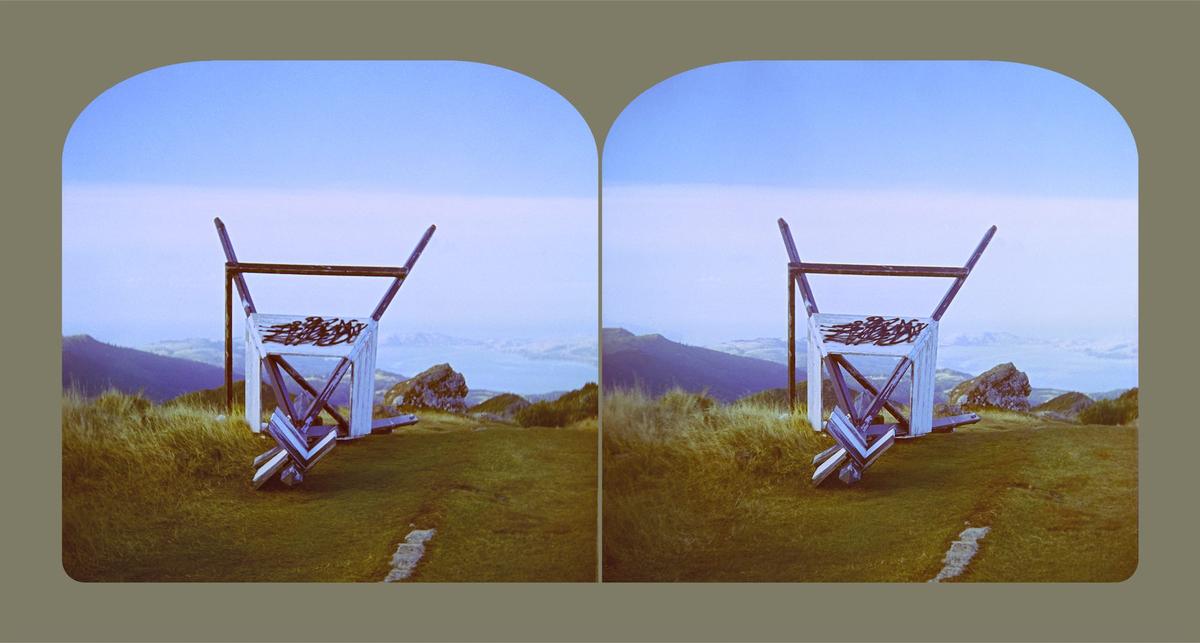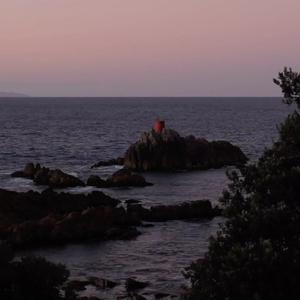Katherine Mansfield wrote in her journal in October 1921: "I've been a camera...I've been a selective camera and it has been my attitude that has determined my selection." Bridget Reweti's attitude to the conventions of the landscape photography genre in her exhibition Pōkai Whenua, Pōkai Moana (16 August–30 October 2021) spring from her identity as a Māori photographer. Coming to Dunedin to take up the Frances Hodgkins Fellowship in 2020, she has used the opportunity to weave links between her own explorations of place and those of a traditional ancestor or tipuna, Tamatea. Tamatea was kaiārahi (navigator) of the Takitimu waka that travelled from the fabled place of origin Hawaiki and made landfall at Mauao (Mount Maunganui), close to Reweti's turangawaewae at Tauranga Moana. Tamatea is also part of a legendary narrative that tells how the Takatimu waka travelled along the coast to Te Waewae Bay in the far south of Murihiku, where it is said to have capsized. A small island close to shore is known as Te Puka o Takatimu—or anchorstone of the waka.
Pōkai Whenua, Pōkai Moana is a kind of navigation or re-tracing of traditional journeys that help enshrine and affirm whakapapa, while also acknowledging the mana whenua of Kai Tahu. The exhibition emphasises the collective memory of Bridget Rewiti's iwi. It recuperates submerged history and asserts a primacy of location that precedes the arrival of the Pākehā, the European coloniser. And in her inventive combination of the mechanics of photographic techniques with customary art practices, Reweti's mahi also explores how to live more fully or more harmoniously with the environment in a contemporary context.
"The plains are nameless and the cities cry for meaning," wrote Charles Brasch in 1951 in his poem The Silent Land, claiming Aotearoa was a blank slate, an empty land. This Eurocentric assertion by Brasch—who as a philanthropist was also responsible for endowing and enabling the Frances Hodgkins Fellowship—exemplifies an estrangement that dominated New Zealand settler culture until the end of the twentieth century.
Reweti's strategy in response is to play around with photographic lenses and framing devices as metaphors for perception in order to indicate just how blinkered and deceptive this particular colonial myth was. She surprises and unsettles the narrative by subverting traditional aesthetic conventions in four separate but juxtaposed sets of works in this show.
On one side gallery of the Hocken Gallery is How to Drain a Swamp, a set of 21 photographs stacked in seven columns. The names of these—for example, Hereweka 1, Hereweka 2, Hereweka 3 (for Nina)—indicate places around Ōtepoti and depict trig station survey points. They are arranged as colonial-style "stereographs." Nineteenth-century view enthusiasts would purchase two identical photographs in a frame-holder designed to be looked at through binocular viewers or lenses, which rendered them in 3-D. In a way, such scenic views were the optical equivalent of taking psychic possession of a landscape. For the coloniser, to see something was to know it, and to know it was to control it.
If, for nineteenth-century European surveyors, trig stations were an instrument for taming and possessing the land before carving it up, for the Māori who were already present in the landscape, encountering these devices was an anxiety-provoking intrusion.
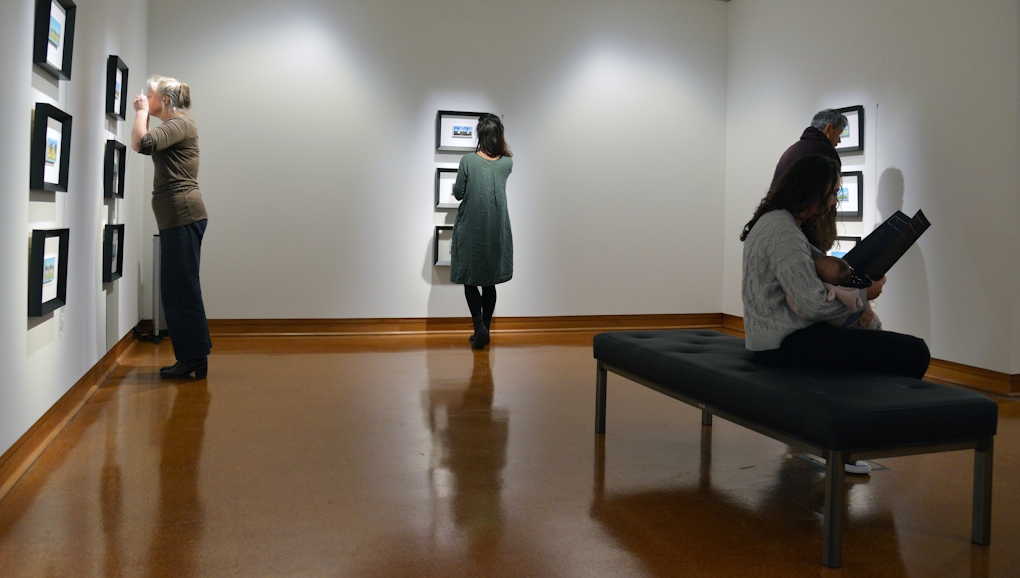
Installation view: How to drain a swamp series in Pōkai Whenua, Pōkai Moana. Photograph: Justin Spiers
Reweti's stereoscopic binocular framing undermines these assumptions. She has made the trig stations faintly absurd and slightly shabby with peeling paintwork. But the colour modulations of her prints also renders her subjects rather pretty: they might be constructivist peg dolls in tented wooden dresses. If, for nineteenth-century European surveyors, trig stations were an intrument for taming and possessing the land before carving it up, for the Māori who were already present in the landscape, encountering these devices was an anxiety-provoking intrusion. They called the survey tools "taipo" or devil, alien. The same term was applied to the camera on its tripod.
So Reweti's assemblage is a space for confrontation with the past. Photographing the trig stations perched on cliff bluffs or on hill tops, she places her camera at a deferential distance but she also shrinks the photograph by placing it in an outsize frame. Thus the documented objects seem enigmatic, fragile, abandoned or neglected. They resemble a parade of humbled symbols, emblems of comic presumption, remnants of an old order. Now they stand on the whenua as if seeking its blessing; the land has become a shrine to a revamped bi-cultural identity and they represent a folkloric iconography sanctified as museological.
In this exhibition tapu remains invested in whenua, or abstracted elements of it, as in the set of works called Kapo Wairua. Rather than a sublimated landscape this is a sublimated landscape compressed into morphological fragments of rock. Reweti displays eight different stones cut and shaped flat on one side, then polished and given a silver gelatin surface. These various stones—onewa (basalt), kōkawa (andesite), pakohe (argillite) — become the base for photograms of bird relics: a toroa skull, a toroa foot, a titi feather, a kuaka feather. Condensed into light-struck silver, they shimmer as if ritualistically enclosed by the dark adamantine stone. Here, kopu wairua are spirit catchers.
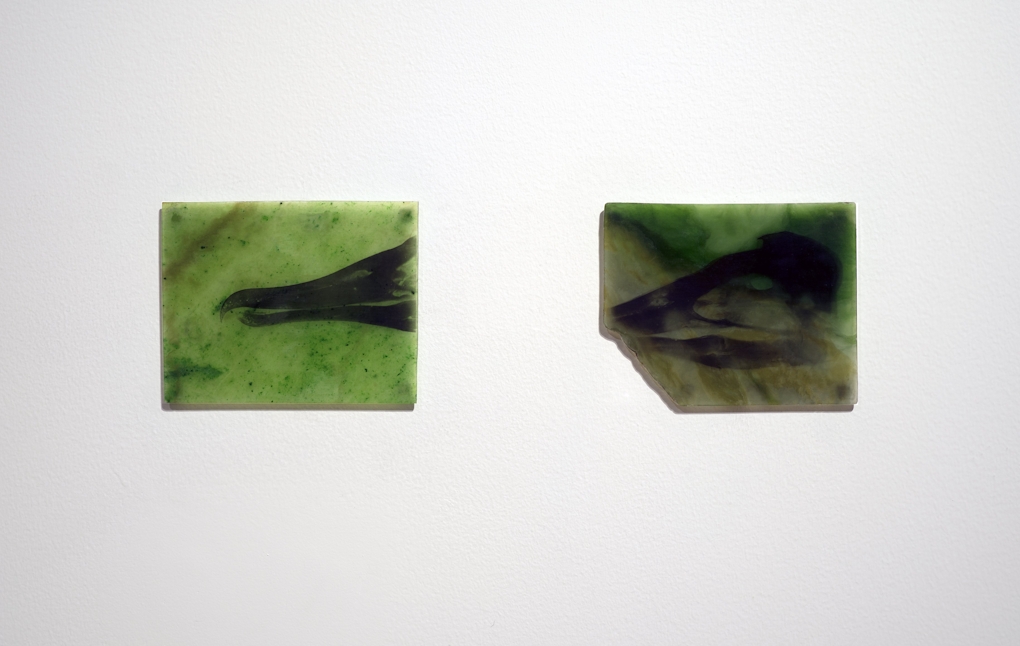
L-r: through the fog it came and the silence of the sea (for Sarah) (2021) Bridget Reweti, pounamu plate negatives. Photograph: Justin Spiers
Tohunga were said to be able to harness mauri and cause it to enter a boulder; likewise, sacred stones were placed in bird snares as talismans to assist with trapping. Reweti traps time. She is a photographer who is also part geologist, part gem-setter.
Pre-contact Māori were a neolithic people who worked stone into a fine art as in pounamu carvings. Reweti has sliced up pounamu and fitted it into her 4x5 camera. The two greenstone plates displayed here, sensitised with chemicals, hold eerie swirling forms conjured out of sunlight. These touchstone pounamu glow, as if ancient taonga imbued with mana. An eye might seek to penetrate the dark green penumbra, but retires baffled by what is embedded within: the unhomely, the uncanny, illuminated shards taken from the dream-time of the land.
Colonial photography has left behind haunted gothic landscapes, but it failed to detect the allegorical and oracular terrains created by Māori. In her series Summering on Lakes Te Anau and Manapouri, Reweti follows the trail left by Alfred Burton in his photographic album Wintering on Lakes Te Anau and Manapouri (1889). These photos have descriptive captions inscribed onto the negatives, written in reverse and appearing as white text when the photo was printed. The negative number was included to protect copyright.
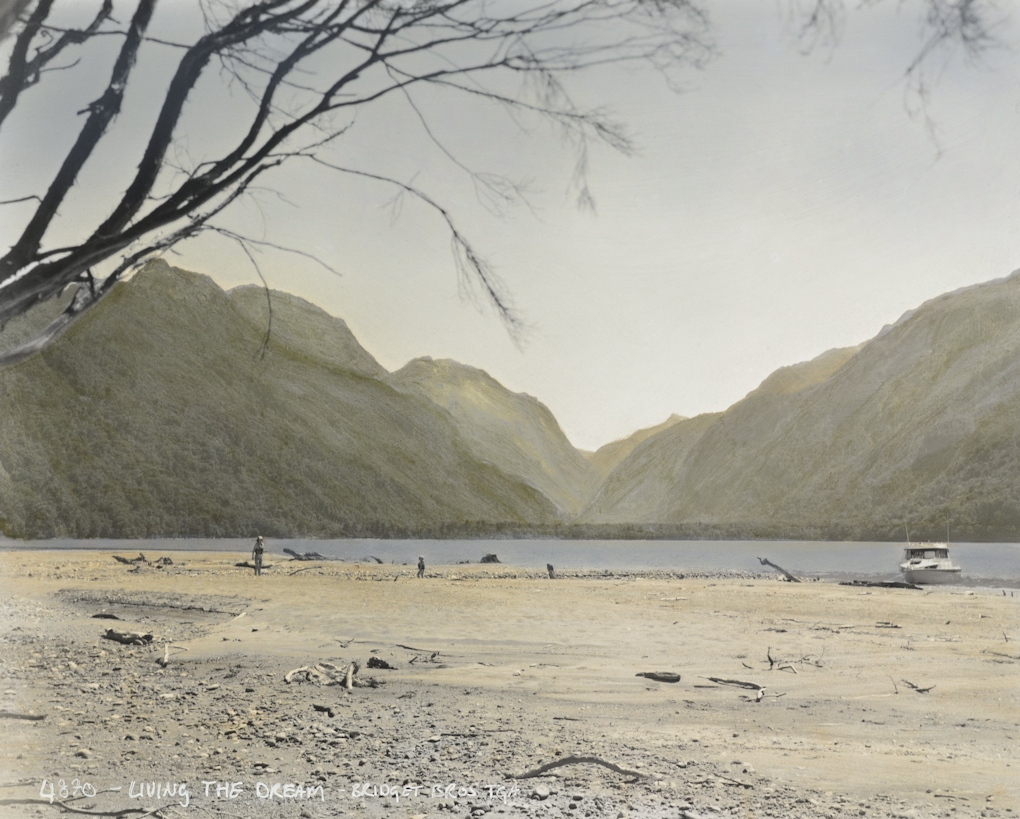
4870 - LIVING THE DREAM (2021) Bridget Reweti. whenua coloured silver gelatin photograph. Courtesy of artist.
Reweti's strategy is to play around with photographic lenses and framing devices as metaphors for perception, in order to indicate just how blinkered and deceptive this particular colonial myth was.
All photographs, as Susan Sontag wrote, wait to be explained or falsified by their captions. Taking her photographs at the same spots as Burton did, Reweti has inscribed them with droll, laconic captions that suggest cryptic postcard notations—for example, 4951 Not Sure I Took the Lens Cap Off. Her photos convey today's touristic spirit as slightly jaded and languid. (She travelled into these regions by tourist launch, with others.)
And yet the idea of the scenic view as promulgated by Burton's photography was created as a commercial propostion. He barbered and trimmed his views with handsaw and machete to make them more appealing to Victorian sentiment. Reweti's camera acknowledges the strategy of scaling the view down to domestic size fit for adorning a mantelpiece or decorating bourgeois domesticity. But in her hands the camera becomes a chamber for realising hidden or camouflaged potentiality. Reweti reaches down into the sacred earth, the whenua to drag up a patina that resembles mud, silt, the weight of history. She has hand-coloured her photographs with clay and soil pigments taken from around the lakes. The earthiness delicately smeared across the photographs makes each of the 40 images an occluded or mediated view. Her figures become indistinct, shadowy, ghostly.
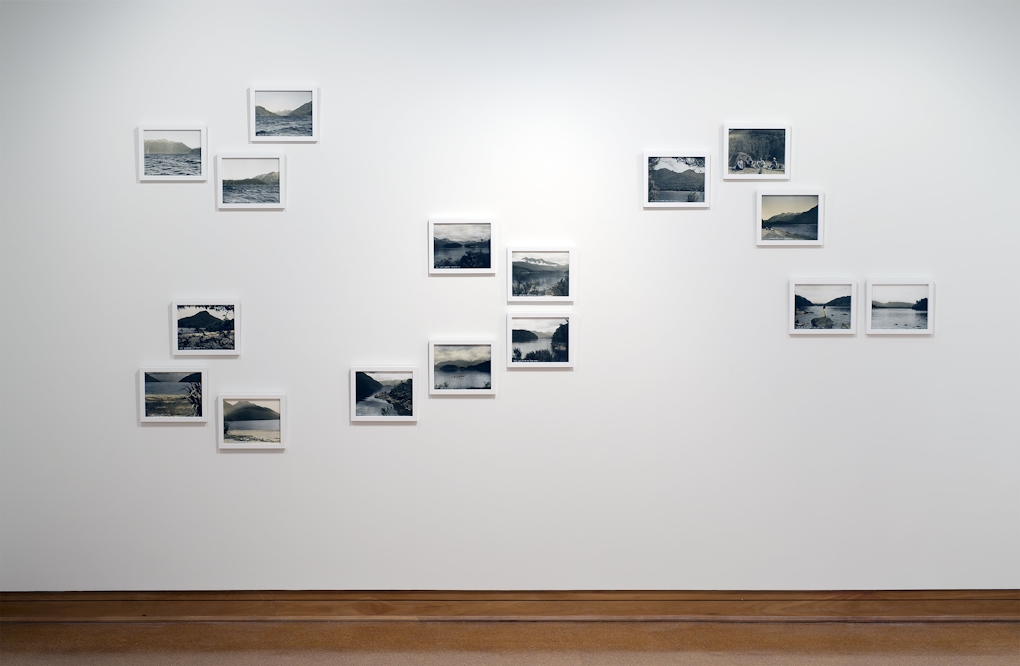
Installation view: Summering on Lakes Te Anau and Manapouri series (2021) Bridget Reweti. Photograph: Justin Spiers
The two-part 59-minute video installation Like a Rock Against the Tide confirms this obsession with continuity, temporality and with the patterns and rhythms we use to subdivide time. Balancing, weighing and evaluating, Reweti offers a contrast between the smallish imprinted stones and the large moving image projection which might stand in for some vast historic panoramic painting on a two-metre stretch of coarse-grained canvas.
Like a rock against the tide (2021) Bridget Reweti
Her video, slightly glitchy or stuttery here and there when I saw it, is an artful tableau which solicits slowed down, trance-like looking. With its view from the base of Mount Maunganui looking out to North Rock Beacon and its flashing warning light, it's a brooding, solemn piece of work. We are keeping vigil along with the camera lens, but little happens: a bird in flight, gusts of wind animate tree branches, the wake of one or two boats. Time itself might be a massive stone weight. But then you notice the video itself begin to compress time, speed it up. Cinema of course sculpts or constructs time: Warhol deals in big slabs; Godard in fragments. Using cinematic techniques, Reweti makes time seem to elongate like bubble-gum, leading into the magic hour of sunset. First in showing us the prolonged view of the seascape at Tauranga Moana, then in the second part at Te Waewae. Then the tide rolls in, ripples wash rapidly ashore, sped up to erase the tyre marks we see left earlier by beach quad bikes.
Attentive to Reweti's attempt to suggest contemplation of Tamatea and the stories of the Takatimu waka, ultimately we are left with a celebration of the quotidian, of everydayness. The day moving at first at glacial speed, walkers on the beach, a dog or two, a runabout passing beyond the warning beacon light which grows stronger in the fading light. Really, this is a celebration of the communal, of its keepsakes and souvenirs and memories. But behind daily life stretches deep time. The video harmonises with the other elements in the exhibition: this is a show about the validity of tradition and custom.
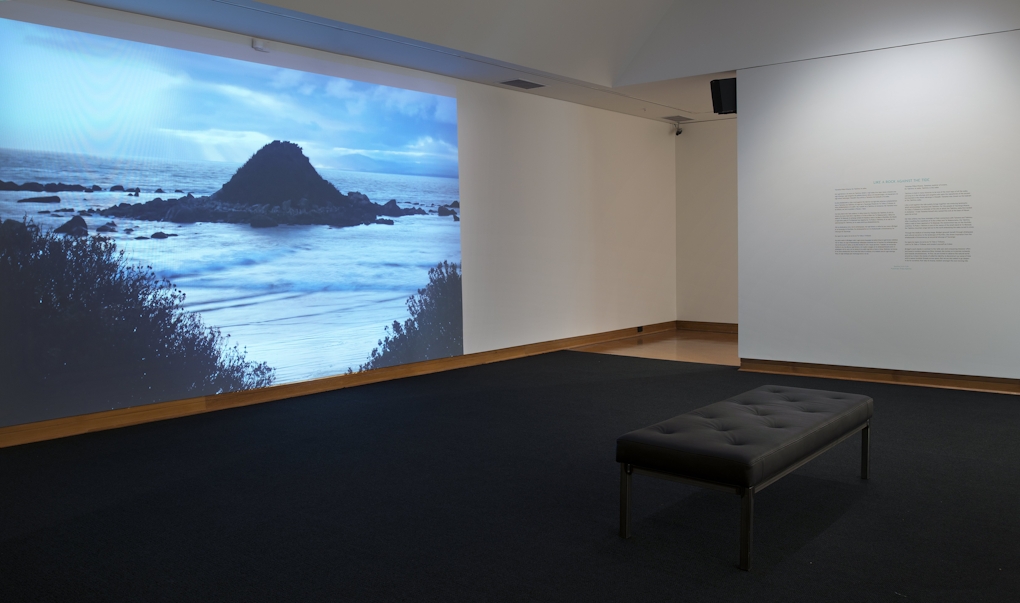
Installation view: Like a rock against the tide (2021) Bridget Reweti. Photograph: Justin Spiers
And to confirm this unity there is the commissioned underscore: a soundscape by taonga puoro composer Alistair Fraser. His audio mimics fragments of modernist musique concrète, or some electronic workshop, and it is mostly made with stones similar to those in the exhibition. These chime like warning bells in a sea-fog, or scrape like the stridulations of crickets, or else they sound like trickling creeks and tapping rain. Struck, they echo mournfully; they bring to mind liturgical chants. In the end they summon ancestors across the gulf of time: the splash of paddles, the thud of a waka hull.
